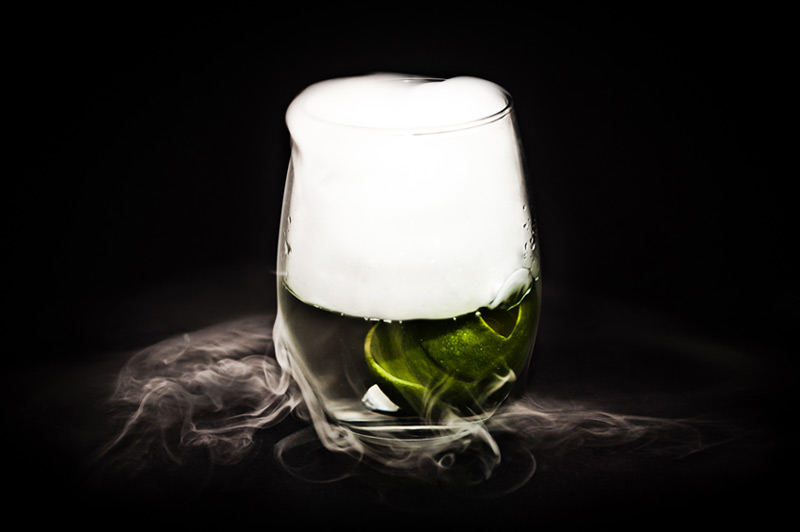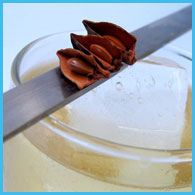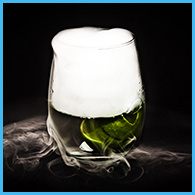Everlasting Gin and Tonic

(Z. T. Bitzer 2011)
The Problem
You sit idly on your chateau’s balcony, surveying the work of your master gardner, Rondingus Brungo, former 3rd-level Druid and failed adventurer. A gin and tonic rests on the granite balustrade with a pool of water slicking the surface underneath; the glass is beaded with a carpet of droplets and you can see the ice slowly melting as if the rays of the sun were focused on your glass like the Eye of Sauron. And your drink is getting more warm and watery by the second.
The Goal
Create a gin and tonic that will maintain a specific temperature (20°F) and dilution (0%) thoughout the time of consumption (20 min).
Possible Solutions
We are actually tackling two problems here: temperature and dilution. The chart below shows the temperature and dilution of a gin and tonic at an ambient temperature of 70F over the course of 20 minutes. For Chart #1 (and all other tests), we used the following recipe:
Gin and Tonic Test #1
- 2.5oz Tanqueray gin (41.3% abv)
- 4oz Fever Tree tonic water @ 37°F
- 1t lime juice
- 4 1oz tivolo ice cubes @ -8°F
For the purpose of these tests, we used an 8oz rocks glass with a diameter of 3″, a height of 3.5″, and a thickness of 1/8″. Add ice cubes, gin, and tonic. Stir for 2 seconds.
Chart #1 – Normal Gin and Tonic
(note: If you hover over each point on the graph, you will see the exact temperature in Farenheit.)
You can see that the optimal time to start consuming your gin and tonic is at the 3-minute mark, and though the drink continues to get colder, your ice cubes are constantly adding water to your gin and tonic. Where this is good when you’re stirring a martini, in a highball, your soda is already providing enough dilution.
The Solution
Dry Ice.
Dry ice is the solid form of carbon dioxide and is really fricken cold: -78.5°F It’s been around in commercial form since 1925 and can be used to preserve food and lab samples, make ice cream, create a fog machine, and even carbonate drinks and fruits. It’s relatively easy to obtain from ice cream shops and mostly safe, unless you’re an idiot. You can handle it without gloves, but not for more than a few seconds, unless you want a real druid to cast Winter’s Embrace on your hands.
Idea #1 – Add dry ice instead of normal ice cubes.
First off, whether this worked or not, we knew it would be fun. Dry ice sublimates much faster in liquid, so you’ll get a pleasant foggy miasma as the dry ice bubbles away in your drink. Inspired by the photography in Modernist Cuisine, this experiment lent itself best to capturing, so that’s the picture at the top of the post.
Chart #2 – Chilled with Dry Ice
Though the temperature drops steadily over time, it never gets close to reaching 20°F – and we put a lot of dry ice in there. Interestingly, the dry ice sublimates faster than the ice cubes melted. It looks like, at least, we solved the dilution problem. Dave Arnold from Cooking Issues is noted for saying that there is no chilling without dilution. Well, we’ve proven that hypothesis wrong, but at the cost of slow chilling. So how do we achieve a colder gin and tonic, faster? By adding dilution back into the mix.
Idea #2 – Make ice cubes out of gin and tonic
What if we were able to create ultra-cold gin and tonic ice cubes, so that when they melted, the didn’t dilute the drink, but just added more gin and tonic to it? The key is that dry ice is cold enough to freeze gin, at least when it’s in a solution with tonic. At 62.5% (by volume) of gin, the ice cubes should freeze at -42°F, which dry ice is readily able to handle.
How to Make Gin and Tonic Ice Cubes
Using the same ratio of 2.5 parts gin to 4 parts tonic, combine 5oz of gin, 8oz of tonic, and 2t lime juice and pour into a tivolo tray. This should make 13 1oz cubes, leaving two holes for you to fill however you like. Put the tray inside an insulated container that has at least 5lb of dry ice in it and freeze for 1 hour. These cubes will not be easy to remove from the tray, and I recommend using a towel or cutting glove.
Chart #3 – Chilled with Gin and Tonic Ice Cubes
The temperature dropped quickly, eventually reaching 18.7F and staying that way well past the 20 minute mark. After several tests, 3 gin and tonic ice cubes seemed ideal; any more and the drink nearly froze solid.
So we’ve done it! A gin and tonic that quickly gets to 20°F, never dilutes, and stays cold for at least 20 minutes. Huzzah!
On a parting note, our friend, Dom, who was around when these tests were being run, offered the following piece of advice: “I can’t believe you need fucking three graphs to make a gin and tonic.”
KP Questions
- What’s your ideal gin to tonic ratio?
- What are your favorite gin and tonic brands?
64 Responses to “Everlasting Gin and Tonic”
You can leave a response, or trackback from your own site.


